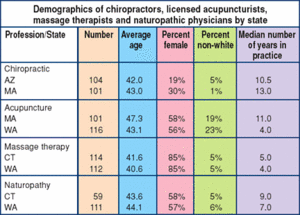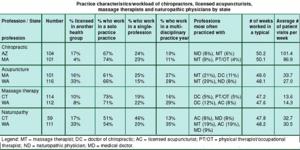Spearheaded by burgeoning scientific and clinical research literature, psychedelics have reached a level of media coverage and popular interest that has not been seen for over half a century. By “psychedelics,” we are referring to the unique class of substances that includes psilocybin (the active compound found in so-called “magic mushrooms”), LSD, dimethyltryptamine (DMT), ayahuasca, 5-MeO-DMT, and mescaline – each of which occurs in the natural world (except for LSD, which is a semi-synthetic compound).
Characteristics of Chiropractors
The Journal of the American Board of Family Practice (JABFP) has published a new study documenting the practice characteristics of providers of complementary and alternative medicine (CAM) in the United States, including doctors of chiropractic. The study, which can be downloaded for free over the Internet, compares the practice patterns of chiropractors with acupuncturists, massage therapists and naturopathic physicians, and provides new, meaningful data on the profession.
In the study, the authors surveyed each of the four types of providers in two states they considered "nationally representative" of the profession being surveyed. States in the Northeast and West were chosen to "enable examination of geographic diversity." For chiropractic, the researchers selected Arizona and Massachusetts; these states, along with Washington and Connecticut, were used for surveys of the other professions. A total of 205 DCs met the criteria for the study, and were interviewed by telephone. During the interviews, the chiropractors answered questions on a variety of subjects, including demographics; training and practice characteristics; practice workload; professional trends; and contributions to the field of health care.
Demographics
- The average age of the chiropractors interviewed was 43 in Massachusetts and 42 in Arizona. These figures were in line with the other professions surveyed, which ranged from 40.6 (massage therapists in Washington) to 47.3 (acupuncturists in Massachusetts.
- An overwhelming majority of chiropractors in Arizona (81%) and Massachusetts (70%) were male; in fact, chiropractic had the highest percentage of male practitioners of any profession surveyed. By comparison, 85% of massage therapists in Washington and Connecticut were female.
- Chiropractic was the most homogenous profession in the survey. Five percent of Arizona DCs, and one percent of Massachusetts DCs were classified as "non-white." While these figures were roughly the same for naturopaths and massage therapists, acupuncture had the highest percentage of non-white practitioners of any profession. Approximately 20% of all acupuncturists were Asian; Hispanics and African-Americans made up less than two percent of the profession.

Training and Practice
- The average length of a training program for chiropractors and naturopaths was four years, compared to three years for acupuncturists and 600-650 hours for massage therapists. Chiropractors and naturopathic physicians were the only professions that offered postgraduate residency training; approximately 5% of the Arizona DCs and 1% of the Massachusetts DCs had completed one year of residency training.
- The average chiropractor had been in practice slightly longer than the average acupuncturist, massage therapist or naturopath. Chiropractors had been in practice an average of 10.5 (Arizona) to 13 years (Massachusetts). Although the researchers didn't speculate, this finding was somewhat surprising, given that Arizona was one of the first states to pass a chiropractic licensing law in 1921, while the law regarding licensure of doctors of chiropractic in Massachusetts wasn't passed until 1966.
- Approximately one-tenth of all chiropractors surveyed (4% in Massachusetts, 17% in Arizona) were licensed in another health profession, most commonly physical therapy, acupuncture or nursing.
- More than two-thirds of the chiropractors in each state operated a solo-practice; Massachusetts DCs had the highest solo practice percentage (74%) of any profession. Substantial numbers of DCs either worked in a single-profession group practice (24% in AZ, 23% in MA) or in multidisciplinary settings (10% in AZ, 11% in MA). DCs most often worked with massage therapists (9% in MA, 6% in AZ). Less than 10% of all alternative health care providers surveyed worked with medical doctors.
Practice Workload
- DCs worked an average of just over 50 weeks per year, more than any other profession. Massage therapists worked the fewest number of weeks per year (47.2 in Connecticut, 47.6 in Washington).
- Chiropractors saw far more patients than any other profession surveyed. In a typical week, a chiropractor had between 86.9 (Massachusetts) and 101.4 (Arizona) patient visits, and 29.1-30.0 hours of direct patient contact - again, more than any other profession surveyed. This translated into seeing approximately three patients per hour of direct patient care. In comparison, massage therapists in Connecticut saw as few as 13.6 patients in a typical week.

Trends
- Chiropractors are graduating at an older age than their predecessors. The researchers compared statistics on alternative health care providers who completed basic professional basic training before 1990 with those who had completed training during the 1990s. According to this analysis, "the average age at completion of basic training was about six years older for recent acupuncturist graduates, and about three years older for recent graduates of the other CAM programs" compared to the graduation age of CAM providers who completed their training before 1990. This could relate to the growing number of people who have embarked on chiropractic as a second career. It could also signify that many health care professionals, having already established themselves in one field, are interested in learning more about chiropractic as a safe, natural alternative to allopathic medicine.
Contributions to Health Care
- More people are seeing doctors of chiropractic, and in far greater numbers, compared to their complementary and alternative counterparts. Using data obtained in the survey, the researchers estimated that more than 5.8 million visits were made to chiropractors in Massachusetts and more than 5.2 million visits were made to DCs in Arizona each year. Acupuncture was the next most "visited" profession, but the number of patient visits to acupuncturists paled in comparison.
- For every 100 people in a given state, the researchers estimated there would be 122 visits to a chiropractor during one year in Arizona, and 85 visits to a chiropractor in Massachusetts. Visits were considerably lower for the other professions.
- One reason for the high number of patient visits could be that, except for massage therapists, there are more chiropractors in practice than any other profession surveyed. In Massachusetts, for example, the researchers estimated there are 195 doctors of chiropractic per million people, compared to only 51 acupuncturists. In Washington, a state with roughly the same population as Massachusetts, there were only 35 naturopaths per million people.
Commentary
Unfortunately, the JABFP study did not include more extensive information on the chiropractic profession, such as the types of conditions chiropractors most frequently treat; the techniques they use in practice; or the number of practitioners who belonged to a managed care network. The researchers explained that they limited their study to two states per profession because of "the lack of national listings of licensed providers and the resources to conduct surveys in all states."
Nevertheless, the study does provide important background information on chiropractors, particularly in comparison to other alternative health care providers, and serves as a valuable statistical companion to the Job Analysis of Chiropractic (2000), published by the National Board of Chiropractic Examiners. The researchers note in their conclusion:
"This study provides an overview of the characteristics of the CAM professionals who provide many of the popular complementary and alternative services in the United States. This information...will be helpful to decision-makers engaged in discussions about how to best integrate CAM providers and services into the health care system."
The complete text of the JABFP article can be downloaded and printed for free at www.familypractice.com, the official site of the American Board of Family Practice. To obtain a copy of the article, visit the following locations:
For a text/HTML version of the article: www.familypractice.com/journal/2002/v15.n05/1505.05/art-1505.05.htm.
For a PDF version of the article: www.familypractice.com/journal/2002/v15.n05/1505.05/1505.05.pdf.
Note: to view the PDF version, you must have Adobe Acrobat installed on your computer. Users can download a free copy of Adobe Acrobat at www.adobe.com.
Reference
- Cherkin DC, Deyo RA, Sherman KJ, et al. Characteristics of licensed acupuncturists, chiropractors, massage therapists, and naturopathic physicians. Journal of the American Board of Family Practice September/October 2002; 15(5):378-390.



